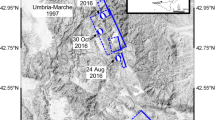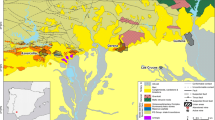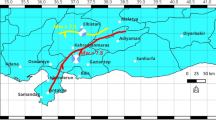Abstract
In this paper, we describe the investigations and actions taken to reduce risk and prevent casualties from a catastrophic 210,000 m3 rockslope failure, which occurred near the village of Preonzo in the Swiss Alps on May 15, 2012. We describe the geological predisposition and displacement history before and during the accelerated creep stage as well as the development and operation of an efficient early warning system. The failure of May 15, 2012, occurred from a large and retrogressive instability in gneisses and amphibolites with a total volume of about 350,000 m3, which formed an alpine meadow 1250 m above the valley floor. About 140,000 m3 of unstable rock mass remained in place and might collapse partially or completely in the future. The instability showed clearly visible signs of movements along a tension crack since 1989 and accelerated creep with significant hydromechanical forcing since about 2006. Because the active rockslide at Preonzo threatened a large industrial facility and important transport routes located directly at the toe of the slope, an early warning system was installed in 2010. The thresholds for prealarm, general public alarm, and evacuation were derived from crack meter and total station monitoring data covering a period of about 10 years, supplemented with information from past failure events with similar predisposition. These thresholds were successfully applied to evacuate the industrial facility and to close important roads a few days before the catastrophic slope failure of May 15, 2012. The rock slope failure occurred in two events, exposing a compound rupture plane dipping 42° and generating deposits in the midslope portion with a travel angle of 39°. Three hours after the second rockslide, the fresh deposits became reactivated in a devastating debris avalanche that reached the foot of the slope but did not destroy any infrastructure. The final run-out distance of this combined rock collapse–debris avalanche corresponded to the predictions made in the year 2004.















Similar content being viewed by others
Notes
In this paper, the term rockslide is used for all kinds of rock slope instabilities independent of the actual kinematic mode, i.e., this term includes planar, circular and compound slides, topples, spreads, and collapses following the definition of Hungr et al. (2014).
References
Andretta M, Bernasconi G, Corti G, Mastropietro R (2004) OASI: an integrated multidomain information system. Proc. International Conference on Complexity and Integrated Resources Management. International Environmental Modelling and Software Society iEMSs, Osnabrück, Germany, p 6
Blikra L.H (2008) The Aknes rockslide: monitoring, threshold values and early-warning. In: Chen, Z. et al. (Eds): Landslides and engineered slopes: from the past to the future. 10th International Symposium on Landslides and Engineered Slopes. Xian, China, 1 & 2; 1089–1094
Cornelius RR, Scott PA (1993) A materials failure relation of accelerating creep as empirical description of damage accumulation. Rock Mech Rock Eng 26:233–252
Crosta GB, Agliardi F (2003) Failure forecast for large rock slides by surface displacement measurements. Can Geotech J 40:176–191
Crosta GB, di Prisco C, Frattini P, Frigerio G, Castellanza R, Agliardi F (2014) Chasing a complete understanding of the triggering mechanisms of a large rapidly evolving rockslide. Landslides 11:747–764
Dammeier, F, Moore JR, Hammer C, Haslinger F, Loew S (2016) Automatic detection of alpine rockslides in continuous seismic data using Hidden Markov Models. J Geophys Res Earth Surface 121: 351–371
Fukuzono, T. 1985. A new method for predicting the failure time of a slope. In Proceedings of the 4th International Conference and Field Workshop on Landslides, Tokyo, Tokyo Universit Press, p 145–150
Gischig V (2011) Kinematics and failure mechanisms of the Randa rock slope instability (Switzerland). PhD Thesis ETH Zurich No. 19730: p 204
Gischig V, Moore JR, Evans KF, Amann F, Loew S (2011a) Thermo-mechanical forcing of deep rock slope deformation—part I: conceptual study of a simplified slope. J Geophys Res 116(F04010):18
Gischig V, Moore JR, Evans KF, Amann F, Loew S (2011b) Thermo-mechanical forcing of deep rock slope deformation—part II: the Randa rock slope instability. J Geophys Res 116(F04011):17
Gröneng G, Christiansen HH, Nilsen B, Blikra LH (2011) Meteorological effects on seasonal displacements of the Åknes rockslide, western Norway. Landslides 8:1–15
Gunzburger Y, Merrien-Soukatchoff V, Guglielmi Y (2005) Influence fo daily surface temperature fluctuations on rock slope stability: case study of the Rocher de Valabres slope (France). Int J Rock Mech Min Sci 42:331–349
Heim A (1932) Bergsturz und Menschenleben. Fretz and Wasmuth Verlag, Zurich, p 218
Hilker N, Badoux A, Hegg C (2009) The Swiss flood and landslide damage database 1972–2007. Nat Hazards Earth Syst Sci 9:913–925
Hungr O, Evans SG (2004) The occurrence and classification of massive rock slope failure. Felsbau 22(2):16–23
Hungr O, Corominas J, Eberhardt E (2005) Estimating landslide motion mechanisms, travel distance and velocity. In: Hungr, Fell, Couture and Eberhardt (eds). Landslide Risk Management. Proc. of an Int. Conference, Vancouver. Taylor and Francis Group, London
Hungr O, Leroueil S, Picarelli L (2014) Varnes classification of landslide types, an update. Landslides 11:167–194
Krähenbühl R (2006) Der Felssturz, der sich auf die Stunde genau ankündigte. Bull für angewandte Geologie 11(1):49–63
Loew S, Willenberg H, and Eberhardt E (2004) Hanginstabilität und Gefahrenanalyse der Alpe di Roscioro (Preonzo, TI). Geologischer Bericht Nr.: ETH 3465/45, ETH Zurich, Geologisches Institut. Professur für Ingenieurgeologie
Loew S, Gischig V, Moore J, Keller-Signer A (2012) Monitoring of potentially catastrophic rockslides. In: Eberhardt, E., Froese, C., Turner, K. and Leroueil, S. (eds). Landslides and engineered slopes: protecting society through improved understanding. Proceedings of the 11th International and 2nd North American Symposium on Landslides and Engineered Slopes, Banff, Canada, Taylor and Francis Group, London: 101–116
Michoud C, Bazin S, Blikra LH, Derron MH, Jaboyedoff M (2013) Experiences from site-specific landslide early warning systems. Nat Hazards Earth Syst Sci 13:2659–2673
Sättele M, Krautblatter M, Bründl M, Straub D (2015) Forecasting rock slope failure: how reliable and effective are warning systems? Landslides. doi:10.1007/s10346-015-0605-2
Schindler C, Cuénod Y, Eisenlohr T, Joris CL (1993) Die Ereignisse vom 18. April und 9. Mai 1991 bei Randa (VS): ein atypischer Bergsturz in Raten. Eclogae Geol Helv 86(3):643–665
Schuster RL (1996) Socioeconomic significance of landslides. In: Turner AK, Schuster RL (eds) Landslides: investigation and mitigation. National Academy Press, Washington, pp 12–35
Sidle RC, Ochiai H (2006) Landslides: processes, prediction, and land use. Water resources monograph 18. Amer. Geophys. Union, Washington, p 312
Signer A (2010) Structural and kinematic analysis of the Roscioro rock slide, Preonzo. Switzerland. MSc Thesis ETH Zurich, Zurich, p 92
Tarchi D, Casagli N, Moretti S, Leva D, Sieber AJ (2003) Monitoring landslide displacements by using ground-based synthetic aperture radar interferometry: application to the Ruinon landslide in the Italian Alps. J Geophys Res 108(B8):2387
Voight B (1988) A method for prediction of volcanic eruption. Nature (London) 332:125–130
Willenberg H, Eberhardt E, Loew S, McDougall S, Hungr O (2009) Hazard assessment and runout analysis for an unstable rock slope above an industrial site in the Rivera valley, Switzerland. Landslides 6:111–116
Xiao J-Q, Ding D-X, Xu G, Jiang F-L (2009) Inverted S-shaped model for nonlinear fatigue in rock. Int J Rock Mech Min Sci 46:643–548
Acknowledgments
We would like to thank M. Franzi (Dipartimento del Territorio/Sezione Forestale Ticino) for providing data from Preonzo and many fruitful discussions. Several colleagues from ETH Zurich (H. Willenberg, M. Ziegler, R. Seifert, A. Kos) and UBC Vancouver (E. Eberhardt, O. Hungr) provided important contributions to the studies presented in this paper. We would like to acknowledge special support of M. Ziegler for postfailure photogrammetric analysis. We also thank three anonymous reviewers for their detailed comments.
Author information
Authors and Affiliations
Corresponding author
Rights and permissions
About this article
Cite this article
Loew, S., Gschwind, S., Gischig, V. et al. Monitoring and early warning of the 2012 Preonzo catastrophic rockslope failure. Landslides 14, 141–154 (2017). https://doi.org/10.1007/s10346-016-0701-y
Received:
Accepted:
Published:
Issue Date:
DOI: https://doi.org/10.1007/s10346-016-0701-y




